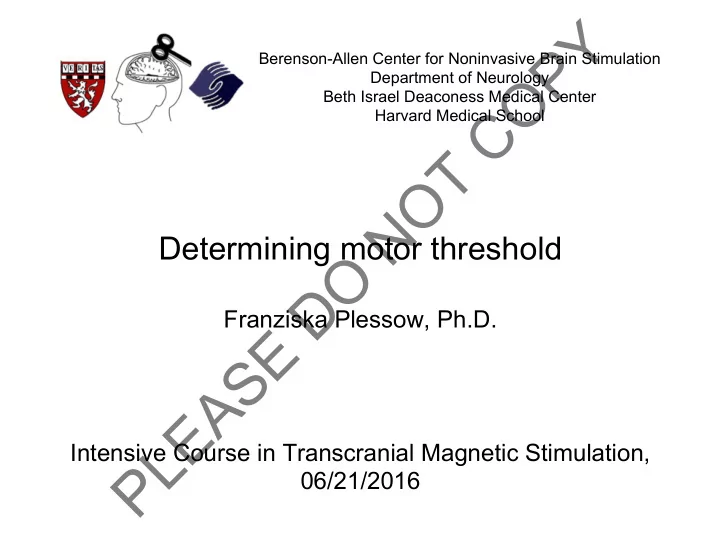

Y P Berenson-Allen Center for Noninvasive Brain Stimulation O Department of Neurology Beth Israel Deaconess Medical Center C Harvard Medical School T O N Determining motor threshold O D Franziska Plessow, Ph.D. E S A E L Intensive Course in Transcranial Magnetic Stimulation, P 06/21/2016
Y P What are the learning objectives of this session? O C 1. What is motor threshold (MT)? T 2. Why do we determine MT? O N 3. What types of MT can be determined? 4. What are the available methods to determine MT? O 5. What are the key steps for determining resting MT with D electromyography? E S A E L P à Hands-on practice Determining motor threshold 2
Y P What is motor threshold (MT)? O C § The minimum amount of machine output necessary to T elicit a motor response in a participant or patient in at least O 50% of all attempts N § Represents membrane-related excitability of cortical axons O § Depends on: D - Inter- and intraindividual variance E - Device (stimulator and coil) S - Type of MT A - Method of determination E - Hemisphere stimulated L P Determining motor threshold 3
Y P Why do we determine MT? O C § Easy to observe T § Objective (e.g., phosphene threshold) O N § Indicator of relative cortical excitability § A way of calibrating and normalizing TMS coil output O energy for inter- and intraindividual physiologic variability D in experimental designs and therapeutic applications E § Determines dosage and safety limits S A E L P Determining motor threshold 4
Y P What types of MT can be determined? O C > Resting motor threshold (RMT) Active motor threshold (AMT) T O N O D E S A E L P Determining motor threshold 5
Y P What are the available methods to determine MT? O C Electromyography (EMG) Visual inspection T O N O D E S A + E L P Determining motor threshold 6
Y P RMT with EMG O C § The minimum amount of machine output necessary to T elicit a motor response in a participant or patient in at least O 50% of all attempts N à Minimum single-pulse stimulator output intensity O resulting in motor evoked potentials (MEPs) of at least D 50 µV peak-to-peak amplitude in ≥ 50% of n consecutive trials ( ≥ 5/10; Rossini-Rothwell method) E S µV µV A E L P s s Determining motor threshold 7
Y P What are the key steps for determining RMT with EMG? O C 1. Choosing an output target T 2. Setting up and ensuring safety O N 3. Finding the “hot spot” (adjusting location) 4. Finding the MT (adjusting intensity) O D E S A E L P Determining motor threshold 8
Y P 1. Choosing an output target O C T O N O D E S A E L P Determining motor threshold 9
Y P 1. Choosing an output target O C T O N O D E S A E L P Determining motor threshold 10
Y P 2. Setting up and ensuring safety O C T O N O D E S A E L P Determining motor threshold 11
Y P 3. Finding the “hot spot” O C ≈ 5 cm lateral from the vertex T O N O D E S A E L P (Jaspers, 1958) Determining motor threshold 12
Y P 3. Finding the “hot spot” O C ≈ 5 cm lateral from the vertex T O N O D Preaurical point E S A E L P (Jaspers, 1958) Determining motor threshold 13
Y P 3. Finding the “hot spot” O C T O N O D E S A E L P Determining motor threshold 14
Y P 3. Finding the “hot spot” O C 1. Set intensity to 30% and deliver a couple of pulses T 2. Go up in steps of 5% until MEPs are observed O N 3. Deliver several pulses to ensure a consistent response is evident (suprathreshold) O 4. Test eight spots around the location of the MEP D E S A E L P Determining motor threshold 15
Y P 3. Finding the “hot spot” O C 1. Set intensity to 30% and deliver a couple of pulses T 2. Go up in steps of 5% until MEPs are observed O N 3. Deliver several pulses to ensure a consistent response is evident (suprathreshold) O 4. Test eight spots around the location of the MEP D 5. Repeat Step 4 until the individual’s “hot spot” is identified E S ✓ A E L Whatever you do, do it consistently. P Determining motor threshold 16
Y P 4. Finding the MT O C 1. Record 10 MEPs T 2. Progressively lower intensity until ≥ 5/10 runs show an O MEP of ≥ 50 µV = MT (1-2%) N 3. Continue until you have <5/10, then go one up again O D E S A E L P Determining motor threshold 17
Y P 4. Finding the MT O C § Alternatives under time constraints: T - ≥ 3/6 O - Adaptive MT determination/Parameter estimation by sequential N testing (PEST) with the TMS Motor Threshold Assessment Tool (clinicalresearcher.org) O § Trouble shooting: D - No MEP detected (relaxation, AMT, silence period) E - MEP latencies > 150 ms S - Expectation A E L P Determining motor threshold 18
Y P O C T Thank you for your active participation O and good luck for the rest of the week! N O For further questions, contact me at any time: D Franziska Plessow fplessow@mgh.harvard.edu E S ? A E L ? P Determining motor threshold 19
Recommend
More recommend